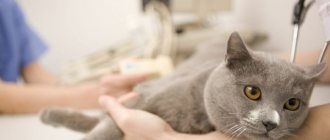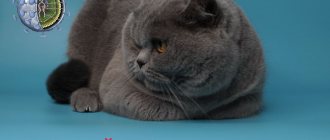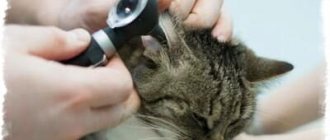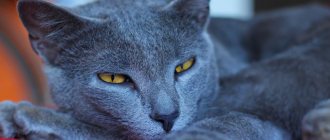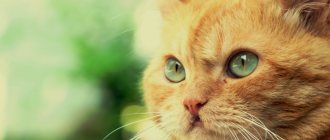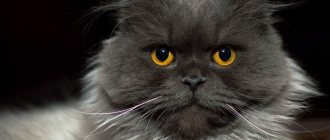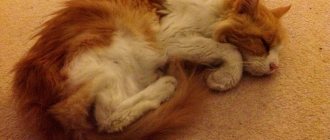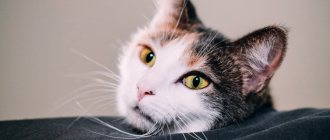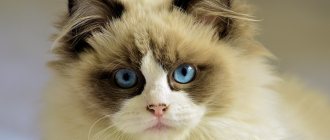The inflammatory process in a cat's gum tissue is called gingivitis. It can affect the gum tissue around one tooth or spread throughout the mouth. Pathology precedes the development of periodontal disease and stomatitis (inflammation of the mucous membranes of the mouth, including the pharynx). The main factors for recovery are timely detection of the disease and prevention of plaque and tartar in the pet.
Our article will help you identify the symptoms of gingivitis in a cat at home. You will learn about the details of diagnosing the disease and subsequent treatment of the animal with medications, medical procedures and folk remedies.
What factors contribute to the development of gingivitis?
Gingivitis is an inflammatory process that develops in the gums, affecting the area around one or more teeth. Gum inflammation is the beginning of a destructive syndrome in the tissues surrounding the bone structure.
The mechanism of action of gingivitis is as follows: first it affects the gums, then the ligaments and bones on which the teeth are attached. According to veterinarians, gingivitis is nothing more than the beginning of a difficult and difficult to treat disease - periodontal disease.
The reasons that provoke the development of gingivitis can be divided into internal (endogenous) and external (exogenous). Internal factors include:
- vitamin deficiency;
- abnormal arrangement of the lower and upper teeth at the moment of closing the jaws (bite);
- hardened plaque;
- caries.
External causes of the disease are considered:
- wounds of the oral cavity caused by tubular bones and other sharp objects;
- radiation received as a result of radiation therapy, x-rays, etc.;
- infections;
- viruses (calcivirus, herpes, etc.);
- exposure to chemical elements.
Gingivitis can occur in any pet, regardless of breed; at risk are animals aged 5 years and older, an unbalanced diet, blood pathologies, and autoimmune diseases.
Causes of inflammation
Gingivitis is usually infectious in nature. Its occurrence is provoked by mechanical or chemical damage to the gum tissue (that is, wounds from sharp objects or damage from toxic substances). Microbes settle on the damaged area of the gum, causing inflammation and swelling, which spread further over time. The inflammatory process affects the area around one tooth, and sometimes several.
Also, gum inflammation is greatly promoted by the lack of basic oral care. There are other culprits for the appearance of this disease:
- lack of vitamins and minerals leads to decreased immunity;
— incorrect bite provokes the formation of ulcers from crowded teeth;
— the presence of infectious agents such as calcivirus and others;
- caries;
- tartar;
- disorders in the endocrine system.
Main symptoms
An attentive owner can easily identify signs of gingivitis in his pet. The animal becomes lethargic and apathetic, sometimes showing aggression and irritability. A visual examination of the oral cavity shows red, swollen gums. The characteristic clinical picture of gingivitis is incessant drooling mixed with blood.
A foul odor comes from the animal’s mouth, caused by the decomposition of food debris and the activity of pathogenic microorganisms.
The cat feels pain in the gums, due to which it cannot chew or eat. As the disease progresses, he loses a lot of weight and becomes weaker.
If you suspect gingivitis in your four-legged pet, the owner should immediately take the furry cat to the veterinarian. Delay is fraught with the spread of infection, damage to the liver, kidneys and other internal organs and systems.
Feeding a kitten with gingivitis
The diet of a sick pet differs from its usual diet. The main thing is that the food is soft and warm. If the fluffy ate dry food, then in this case such food must be soaked. The menu includes pates and canned food (professional food) for animals with sore gums.
Fatty, fried, salty foods and cold or hot water should be excluded from the diet. Although such products should not be present in the diet of cats at all.
Read about the dangers of table food: Is the best food for a cat from the table? (myths and reality)
Treatment methods
Severe forms of gingivitis are treated comprehensively. If the pathology was diagnosed at the initial stage, then brushing your teeth will be quite enough. Experts warn: toothpastes intended for humans should not be used.
The concentration of some components in cleaning products is very high and negatively affects the health of the fluffy. In addition, cats do not like the menthol aroma that is present in most formulations.
To clean plaque, a special brush is used, which can be purchased at any veterinary pharmacy. If this is not possible, a regular toothbrush intended for children 3-5 years old will do. The bristles of these brushes are very soft and safe.
Miramistin, Chlorhexidine and other special disinfectant solutions are used to treat the oral cavity. After treatment, the gums are lubricated with “Zubastic” or “Dentavedin” gels.
In the later stages, medication and sanitation in a veterinary clinic are indicated. The cavity is cleaned using an ultrasonic scaler.
The drug Interferon is effective in the fight against gingivitis. It stops the development of pathology, preventing its transition to severe stages. In addition, the product has a powerful immunostimulating effect.
The drug is well absorbed by animals and belongs to the category of harmless, not causing side effects, including allergies. Despite this, only a veterinarian can prescribe it and set the dosage and duration of treatment.
To treat advanced forms of gingivitis, antibiotics (Lincomycin, Clindamycin, Stomorgyl, Convenia) and immunosuppressants (Prednisolone, Azathioprine, corticosteroids) are used.
Tooth extraction is indicated only in the most severe cases, since a toothless cat becomes disabled. But if the veterinarian makes such a decision, it means that there is no other way to eliminate the cause of the disease and the direct source of pathogenic microflora.
With timely and adequate treatment, the prognosis is favorable.
Prevention of gingivitis
To prevent damage to oral tissues, it is necessary to regularly brush your cat's teeth. The procedure takes only a few minutes, but the benefits are significant. Manipulation allows you to strengthen the enamel, prevent the appearance of carious cavities, stomatitis and periodontitis.
To treat your teeth, you can brush them with Tropiclean paste. This gel is safe because it contains medicinal plants. The drug does not have a pronounced menthol aroma, which is unpleasant for cats. You can brush your teeth and gums with gel once a week. At the veterinary pharmacy you can also buy Radiance and Elgidium pastes, special cleaning powders for animal teeth.
Advice! Your cat should have his own chew toys. They help train your jaws and strengthen your teeth. At a veterinary pharmacy or pet store you can purchase various rubber products for your cat, with which she will willingly spend time.
It is important to eliminate poor nutrition and feeding low-quality cheap food from your cat’s life. To prevent pathological changes, you can give special solid foods with certain components that improve the structure of the gums and teeth. Such food is purchased in specialized pet stores.
What to do at home
The owner must provide his pet with the most comfortable living conditions and strictly follow the veterinarian’s instructions. You should not self-medicate, as this can aggravate the situation and cause irreparable harm to the cat’s health.
You can alleviate the suffering of a fluffy with the help of a soda solution or decoctions of medicinal herbs that have a disinfectant and antimicrobial effect. However, traditional methods cannot replace traditional treatment and are used as additional measures.
A decoction of chamomile, oregano, and strawberry leaves has worked well. You need to boil 1 teaspoon of the dried plant, pour a glass of boiling water, and cook over low heat for 10 minutes. Then strain the broth, cool and use to wipe the animal’s mouth.
During gingivitis, a cat usually refuses to eat, since even a small, barely chewed piece causes her pain. However, to defeat pathology, the body needs strength. Your four-legged pet should be fed with special soft food intended for weakened cats, pureed meat and vegetables, meat or chicken broth.
Features of caring for a sick cat
At home, a sick cat should expect complete rest and nutritious food. It is necessary to protect the animal from stress. Since a cat does not eat well with gum disease, you should not force it. It's better to give her a little treat that she's unlikely to refuse.
The diet should include porridge and meat purees; dry food is contraindicated in case of illness. The food should be warm (but not hot) and tasty for the cat. Then there is a high probability that the sick animal will still touch the food.
It is necessary to give your pet, weakened by illness, plenty of sleep. Sleep is the most acceptable medicine for animals. A cat suffering from gingivitis is placed in a quiet, calm place, away from noise. If there are children in the house, they should not disturb the pet.
Possible complications
Even mild forms of gingivitis, if not treated correctly, can result in the development of plasmacytic-lymphocytic gingivitis - an ulcerative lesion of the oral mucosa. The danger of the disease is that ulcers form not only on the gums and around the teeth, but also in the larynx and esophagus.
Since the animal cannot eat normally and swallows food whole, disorders of the gastrointestinal tract, metabolic processes, and intestinal blockage cannot be ruled out.
If left untreated, gingivitis progresses to periodontal disease, characterized by tooth decay and loss. The pathology is characterized by severe pain, festering wounds, and ulcers in the oral cavity. In the future, complete destruction of individual parts of the oral cavity can be observed, and in severe cases, jaw fractures.
In addition, advanced gingivitis creates a threat of infection of the body with toxins that arise during the life of pathogenic microorganisms. The body becomes severely poisoned and sepsis develops. Blood poisoning is accompanied by irreversible pathologies of internal organs.
Diagnostics
The cause of the disease is determined by a veterinary dentist. Clinical signs are taken into account and anamnesis is collected. Pay attention to the age of the cat, since bleeding during teeth changing is a physiological phenomenon. If the animal was given antibiotics, and the symptoms of gingivitis did not disappear, bacterial culture of the pathological material is carried out for sensitivity to antimicrobial drugs. To identify hidden foci of inflammation, an X-ray of the skull is taken.
If secondary gingivitis is suspected, a blood test is performed to identify the pathogen. When pathology develops in animals under 5 years of age, an autoimmune cause of gingivitis is suspected. In this case, a biopsy of the pathological material and histological examination are performed.
Causes of inflammation on the gums
Gingivitis is the initial stage of periodontal disease in cats, in which tooth loss occurs due to the spread of inflammation and infection from the gums to the roots. Timely correct treatment and compliance with the veterinarian’s recommendations help preserve the health of the animal’s oral cavity and, accordingly, the entire body as a whole.
Possible causes of gingivitis in cats:
- Dental calculus is the appearance of yellow-gray plaque at the bases of the teeth or between them, which occurs due to the accumulation of food debris in hard-to-reach places with their subsequent petrification. As a rule, the stone injures the upper layers of the gums as it hardens. As a result of bacteria entering the wounds, the process of developing gingivitis begins.
- Damage to the gums of a mechanical nature, which occurs due to injury to the mucous membranes by roughage or fish bones.
- Lymphocytic gingivitis is a serious disease in which wounds and ulcers appear in the cat’s mouth due to damage to the oral mucosa by its own immune cells. Presumably this phenomenon occurs due to heredity or under the influence of viruses.
- Aging teeth or malocclusion.
- Impact on the oral mucosa of toxic substances, acids, alkalis, heavy metal salts.
- Feeding soft foods that promote the formation of tartar.
- Self-removal of a loose tooth in a cat.
- Exhaustion of the cat's body due to infection.
- Virus infection, metabolic disorders, lack of vitamins in the body.
- Gout.
- Diabetes.
Development of plaque and tartar
Nature gave cats white teeth. All kinds of shades of gray and yellow indicate a lack or improper care.
Plaque deposition occurs as follows. Pathogenic microorganisms live and multiply in the film of saliva that covers the teeth. Over time, there are more of them, the film thickens and turns into plaque. Most often it is located on the canines and back teeth. Over time, it turns into stone, with certain factors accelerating its formation. Among them:
- the diet contains only soft food;
- incorrect position of teeth;
- violation of salt metabolism.
If plaque is not removed, it can lead to various pathologies - teeth rot, teeth fall out, and problems with gums arise. During self-examination, it is difficult to completely detect plaque - only the areas that are above the gum are visible.
You can remove plaque with a special toothbrush, but not every pet will like this procedure and will tolerate it calmly. There are also special additives for drinking water that prevent tartar deposits.
Preventing gum disease in cats
- Regular preventive examinations of the cat's oral cavity. If small wounds, ulcers, or an unpleasant odor appear, you should consult a doctor for a diagnosis.
- Proper nutrition. If you use ready-made food, you must choose premium mixtures. For prevention, twice a year you can give your cat a specialized “medicinal” food for a week, which contains ingredients that cleanse the oral cavity.
- Regular brushing of teeth . Ideally, your cat's teeth should be brushed 2-3 times a month, using veterinary medicinal products to remove plaque.
Cat's dental system
The organization of the animal's dental system has its own distinctive features. It consists of the following teeth:
- incisors – located in front, with their help the pet captures prey;
- fangs - designed for tearing prey;
- premolars - used for chewing food;
- Molar teeth - designed for crushing food.
From birth, animals have no teeth. After about two weeks, the first incisors appear, followed by fangs and root teeth. Teeth erupt approximately until the end of the first month of life. In total, a cat has 26 baby teeth - 14 at the top and 12 at the bottom.
Between four and eight months, baby teeth are replaced by permanent teeth. During the same period, 4 more teeth grow. In total, an adult animal has 30 teeth - 16 at the top and 14 at the bottom.
